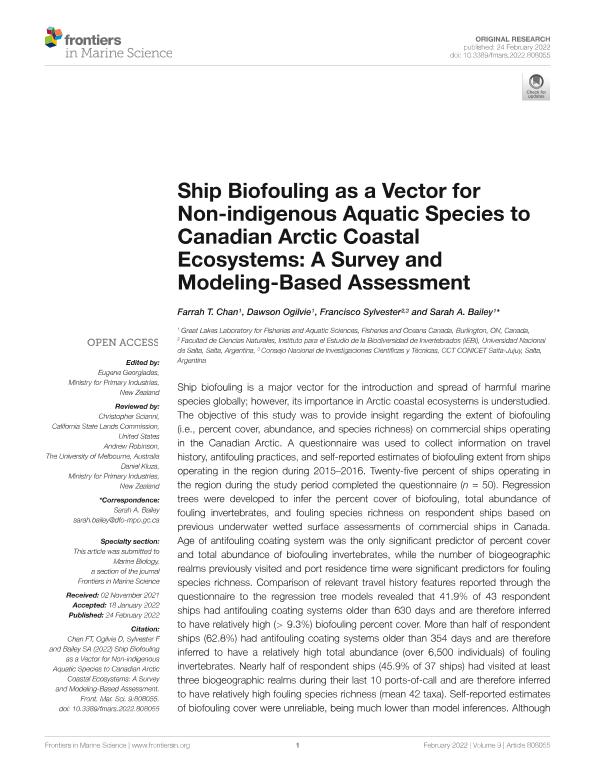Mostrar el registro sencillo del ítem
dc.contributor.author
Chan, Farrah T.
dc.contributor.author
Ogilvie, Dawson
dc.contributor.author
Sylvester, Francisco

dc.contributor.author
Bailey, Sarah A.
dc.date.available
2022-06-23T16:52:34Z
dc.date.issued
2022-02
dc.identifier.citation
Chan, Farrah T.; Ogilvie, Dawson; Sylvester, Francisco; Bailey, Sarah A.; Ship biofouling as a vector for non-indigenous aquatic species to Canadian arctic coastal ecosystems: a survey and modeling-based assessment; Frontiers Media; Frontiers In Marine Science; 9; 2-2022; 1-9
dc.identifier.issn
2296-7745
dc.identifier.uri
http://hdl.handle.net/11336/160370
dc.description.abstract
Ship biofouling is a major vector for the introduction and spread of harmful marine species globally; however, its importance in Arctic coastal ecosystems is understudied. The objective of this study was to provide insight regarding the extent of biofouling (i.e., percent cover, abundance, and species richness) on commercial ships operating in the Canadian Arctic. A questionnaire was used to collect information on travel history, antifouling practices, and self-reported estimates of biofouling extent from ships operating in the region during 2015–2016. Twenty-five percent of ships operating in the region during the study period completed the questionnaire (n = 50). Regression trees were developed to infer the percent cover of biofouling, total abundance of fouling invertebrates, and fouling species richness on respondent ships based on previous underwater wetted surface assessments of commercial ships in Canada. Age of antifouling coating system was the only significant predictor of percent cover and total abundance of biofouling invertebrates, while the number of biogeographic realms previously visited and port residence time were significant predictors for fouling species richness. Comparison of relevant travel history features reported through the questionnaire to the regression tree models revealed that 41.9% of 43 respondent ships had antifouling coating systems older than 630 days and are therefore inferred to have relatively high (> 9.3%) biofouling percent cover. More than half of respondent ships (62.8%) had antifouling coating systems older than 354 days and are therefore inferred to have a relatively high total abundance (over 6,500 individuals) of fouling invertebrates. Nearly half of respondent ships (45.9% of 37 ships) had visited at least three biogeographic realms during their last 10 ports-of-call and are therefore inferred to have relatively high fouling species richness (mean 42 taxa). Self-reported estimates of biofouling cover were unreliable, being much lower than model inferences. Although the regression tree models have relatively low predictive power, explaining only 15–33% of the variance in biofouling extent, this study indicates that commercial ships are an active pathway for the transportation of non-indigenous aquatic species to Canadian Arctic coastal ecosystems via biofouling.
dc.format
application/pdf
dc.language.iso
eng
dc.publisher
Frontiers Media

dc.rights
info:eu-repo/semantics/openAccess
dc.rights.uri
https://creativecommons.org/licenses/by/2.5/ar/
dc.subject
ARCTIC
dc.subject
BIOFOULING
dc.subject
BIOLOGICAL INVASIONS
dc.subject
HULL FOULING
dc.subject
INVASIVE SPECIES
dc.subject
NON-INDIGENOUS SPECIES
dc.subject
REGRESSION TREES
dc.subject
SHIPPING
dc.subject.classification
Ecología

dc.subject.classification
Ciencias Biológicas

dc.subject.classification
CIENCIAS NATURALES Y EXACTAS

dc.title
Ship biofouling as a vector for non-indigenous aquatic species to Canadian arctic coastal ecosystems: a survey and modeling-based assessment
dc.type
info:eu-repo/semantics/article
dc.type
info:ar-repo/semantics/artículo
dc.type
info:eu-repo/semantics/publishedVersion
dc.date.updated
2022-06-21T18:32:44Z
dc.journal.volume
9
dc.journal.pagination
1-9
dc.journal.pais
Suiza

dc.journal.ciudad
Lausana
dc.description.fil
Fil: Chan, Farrah T.. Fisheries and Ocean Canada; Canadá
dc.description.fil
Fil: Ogilvie, Dawson. Fisheries and Ocean Canada; Canadá
dc.description.fil
Fil: Sylvester, Francisco. Consejo Nacional de Investigaciones Científicas y Técnicas. Centro Científico Tecnológico Conicet - Salta; Argentina. Universidad Nacional de Salta. Facultad de Ciencias Naturales. Instituto para el Estudio de la Biodiversidad de Invertebrados; Argentina
dc.description.fil
Fil: Bailey, Sarah A.. Fisheries and Ocean Canada; Canadá
dc.journal.title
Frontiers In Marine Science

dc.relation.alternativeid
info:eu-repo/semantics/altIdentifier/url/https://www.frontiersin.org/articles/10.3389/fmars.2022.808055/full
dc.relation.alternativeid
info:eu-repo/semantics/altIdentifier/doi/https://doi.org/10.3389/fmars.2022.808055
Archivos asociados
